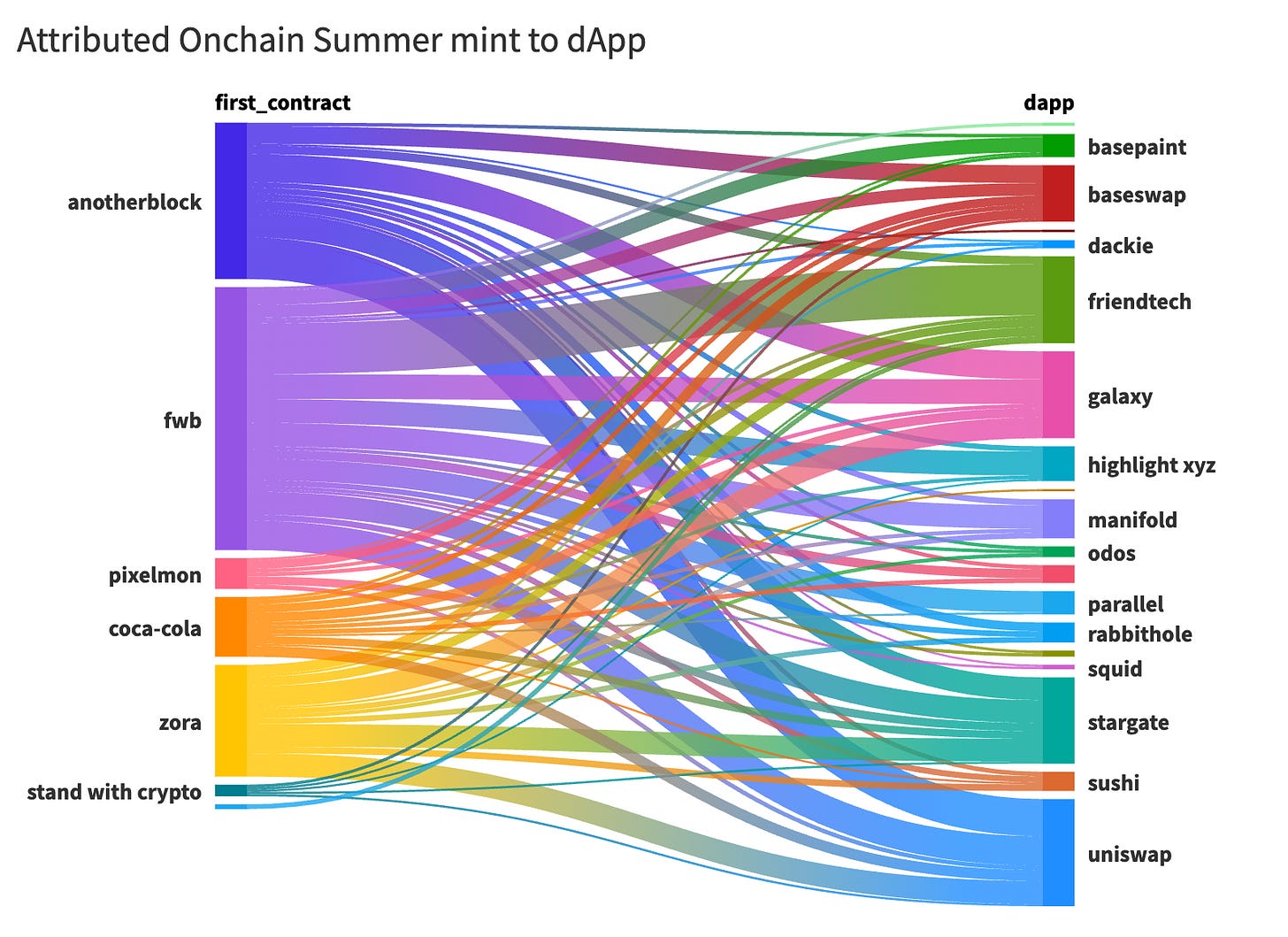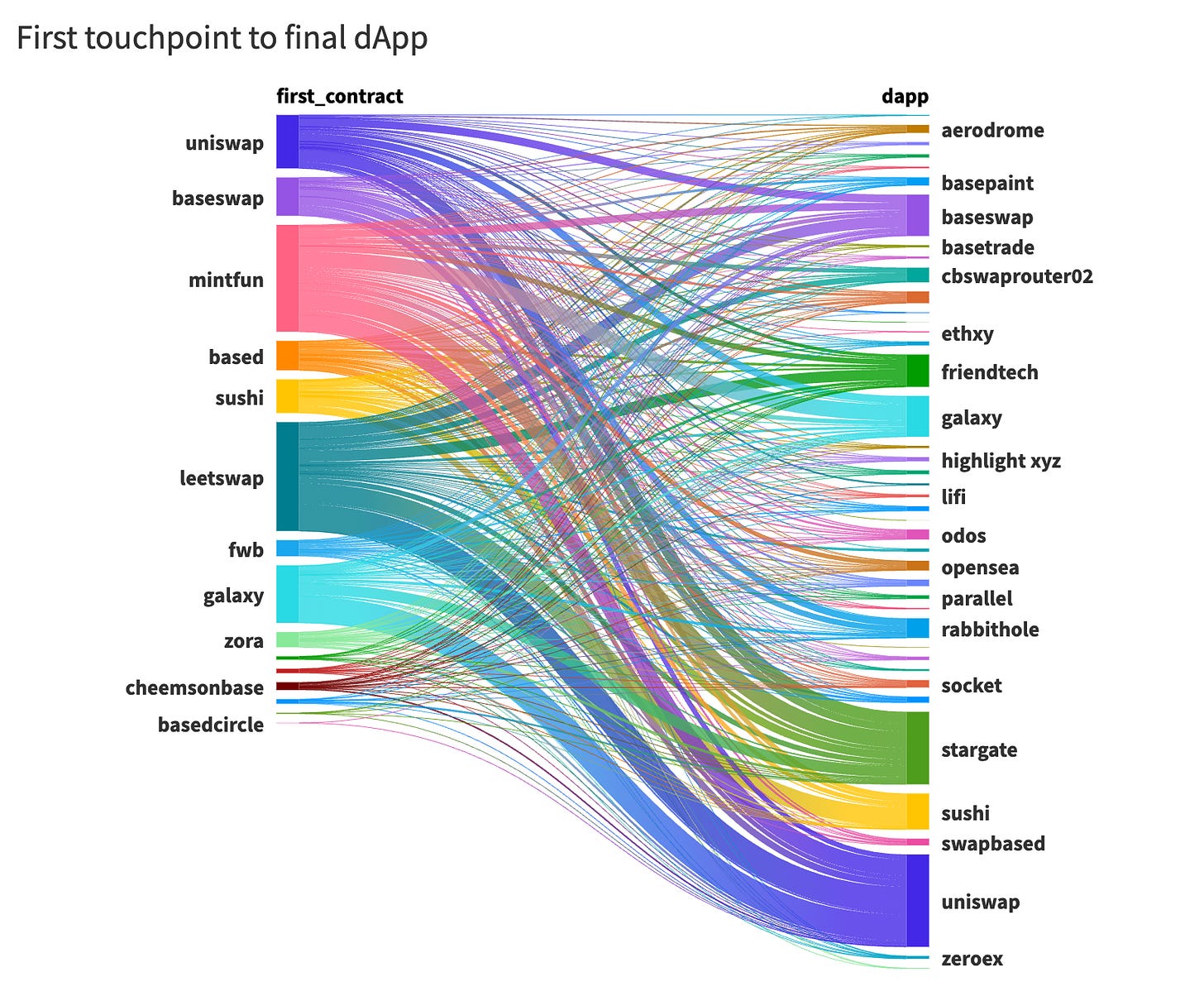Follow the users
Measuring the Base userbase

Reluctantly crouched at the starting line
Engines pumping and thumping in time
The green light flashes, the flags go up
Churning and burning, they yearn for the cup
Cake, 'The Distance'We at Spindl have been very excited about Base. Built on the open-source OP Stack and incubated by Coinbase, with integrations into Coinbase products, the new L2 Base is the perfect storm of consumers, functionality and blockchain infra to indeed make ‘onchain the new online.’
But how’s it doing?
Since launching to mainnet in early August, Base has seen almost 1,200,000 wallets onboard to the chain, and about half a billion dollars in tokens bridged. Dozens of projects have announced Base support (including Spindl), and the chain has taken its place alongside more established ecosystems like Arbitrum and Polygon as a place you need to deploy.
Such meteoric growth among competing dapps on a new chain presents an interesting case study for what Spindl specializes in: onchain growth measurement. It’s rare to have developers arranged at a starting line, raring to go like in the Cake song above, and then see how far they get given the various growth strategies deployed.
It’s also a showpiece for what Spindl does best: onchain measurement and attribution.
Forget for a moment the flurry of regular actions users constantly do, like page views, clicks, and game plays (all of which Spindl also tracks). Even limiting ourselves to transactions on a new blockchain, a user will transit a unique journey—mints, swaps, bridging—until landing on the virtual doorstep of your application. How did they get there, and whom do we thank for their arrival? That function is described by the oft invoked (and misused) term of ‘attribution,’ a core concern of the Spindl product.
Everything in the Web 3 timeline is the reverse of Web 2: infra comes before consumer adoption, intricate economics before viral usage. It may well also be that precise attribution precedes the eventual advertising models that emerge.
What’s the tl;dr?
In Web 2, attribution providers like Branch or AppsFlyer would run a simple ‘last touch’ attribution model to crown the winner of the CPA (cost-per-action) bounty for the desired user action (e.g. a purchase or install). Whoever touched the user last got the prize for acquiring them, and centralized intermediaries like Facebook and Google built trillion-dollar valuations based on winning attribution showdowns. Simple as.
In Web 3, since the attribution winner will often be rewarded with an ongoing percent of user revenue, advertisers seem more comfortable with a first touch model that privileges whoever first brought in the transacting user1. If a project is running a multi-channel strategy of referrals, organic Twitter poasting, regular paid ads and whatever else the marketing person cooked up, only an attribution system can disentangle the touchpoints into something causal and actionable.
Take a relatively simple growth hack: theOnchain Summer site that Base launched to celebrate mainnet. By mapping each featured mint to an onchain action, we permissionlessly measured the efficacy of the growth campaign. Mints are on the left, and all the dApps those mints drove users to are on the right2. Spindl data shows that anotherblock and FWB were the biggest drivers of Base adoption.

Looking beyond the Onchain Summer site, we can look at all the dApps that onboarded users on Base, and do the same first-touch attribution analysis. This is any smart contract that was a user ‘first touch’ for eventual Base usage, pivoted by the downstream dApp3.
If you’re asking the ad-tech boomer question of “you mean to tell me that in a properly-attributed ads model, assuming there was some sponsored app discovery thing running, everyone on the left would be paid by everyone on the right, proportionate to the thickness of the line connecting them?”

Yes, that’s exactly what this Sankey diagram shows. Each flowing line is the attributional weight of an end user for a dApp on the right to someone on the left who first brought them onchain and eventually to that final dApp. If that leftmost NFT or dapp were an ad in Web 2 land, it’s who you’d pay for the user. This is the user acquisition graph for the most popular dApps and NFT projects, during the first three weeks of Base.
As is clear, some first-touch dApps are much better at keeping users onchain than others. Friend.tech, the viral social app, does not drive a lot of other Base usage, even as the app itself has grown in popularity (this is while still joining to the original user wallet, not just the app-specific wallet). The Friend With Benefits (FWB) mint on On Chain Summer was particularly good at driving Base users to other dapps, with a Base retention rate of 38%.

Layer 3, a questing platform, ran a collection of Base-specific quests. As you can see from the left-hand side of the Sankey above, the Layer 3 campaigns drove about as much Base usage as the Onchain Summer website itself (‘others’ was every source except Layer 3 or Onchain Summer). We’ve measured the retention and return-on-advertising-spend (ROAS) of Layer 3 quests before, and have shown they can be an effective user acquisition mechanism.
There will clearly be a role for third-party publishers to permissionlessly (and gainfully) onboard new users onchain. Right now however, with the possible exception of quests, the onchain ecosystem has a serious ‘publisher problem’. Even projects with marketing budget have little (if any) onchain paid media they can buy to drive growth. Like it or not, publishers like Facebook and Google were the engines for Web 2 growth, and even in decentralized form, nothing has really emerged at that scale (yet) in Web 3.
Spindl solves the measurement and referral payout problem, but there isn’t much to measure without a publisher sending users down the funnel. It’s our hope that by providing just that measurement, interesting collaborations can emerge between onchain-native publishers good at making users stick around, and apps looking to give those users something to do onchain.
Everything in the Web 3 timeline is the reverse of Web 2: infra comes before consumer adoption, intricate economics before viral usage, everything literally the reverse order of Web 2 history. It may well also be that, the reverse of Web 2, precise attribution precedes the eventual advertising models that emerge, mapping out the trails that both users (and money) followed.
To get started with Spindl analytics and attribution, contact us.
For more thoughts on Web 3 attribution, subscribe or follow us.
The ‘right’ answer here is the never-realized holy grail of Web 2 marketers: multi-touch attribution. In short, that means weighting the contribution of every upstream touchpoint—video view, FB ad, organic Twitter post, whatever—and evaluating those channels accordingly. That dream was never realized because in the end, via the fiat rails of the Web 2 world, you could really only ever pay one publisher for a user. Even if a sophisticated marketer came up with some multi-factor model for user acquisition (and some did just that) there was no way to put that model into business practice given the relatively crude machinery of Web 2 advertising. A very different world is possible in Web 3.
Actions on the left have obvious onboarding actions like bridging removed as they wouldn’t be particularly enlightening.
Attribution is disorienting, because while time (and user funnels) run forward, the attribution compute runs backward, trying to find the right upstream event (on some other application) to credit for the event on this application right now.
Another way of looking at these Sankeys is: If you took a single application on the right like Uniswap, and looked at the squiggly lines leading to it, the sources of those lines would be the correct apps to credit with Uniswap user growth, and the thickness of those lines are proportional to that source’s contribution.



"Infra comes before user adoption" sounds like a textbook case of a solution looking for a problem. Google didn't invent DFS -which became HDFS and Hadoop, the foundation on which today's big data ecosystem is built - before it had a need for it. Ditto for Amazon and its Dynamo database - they needed a horizontally scaling system without the constraints of an RDBMS. TPU came out of Google's need to run inference at scale across their numerous billion-plus user apps. I've been in software my entire career - 25+ years now - and the "Field of Dreams" approach, i.e. "if you build it they will come" rarely works. And web3 is arguably one of the worst tech stacks for this approach, as even simple things like user onboarding are technically tricky compared to web2, not too mention the massive security risks if you fail to properly secure your wallet. And even if a new user gets all that right the first time, the whole web3 ecosystem is rife with fraud and scammers. So once users have been onboarded they have to constantly be looking over their shoulder, asking themselves "is this dApp something I can trust?" I admire the passion that web3 developers have shown, but I just don't see how building more and more layers and protocols on top of an expensive, low TPS blockchain database is ever going to have the same impact as the HTTP protocol did for computer networking. HTTP enabled the "killer app" required to spark mass web1 adoption - the Netscape web browser. No such technology exists today in the web3 ecosystem. If we're being honest about it, the blockchain was *supposed* to be the tech that drove a sea-change level event in the way HTTP did decades ago. This hasn't happened because the blockchain, despite applying cryptography in an interesting way - is a fundamentally flawed and constrained data store. Building more infra on top of it is not going to be what drives billions of users to transact on chain.